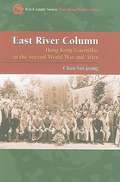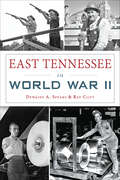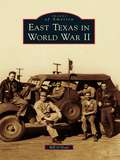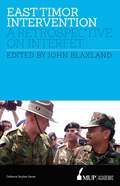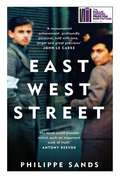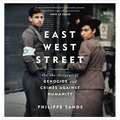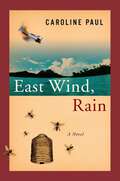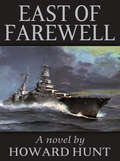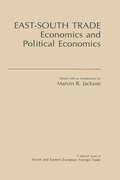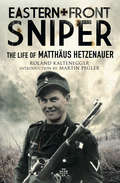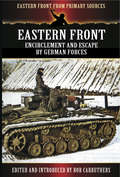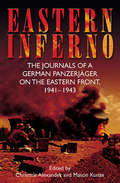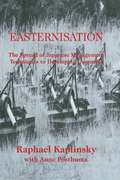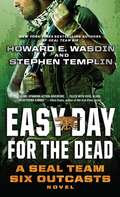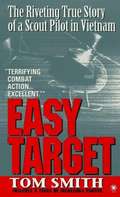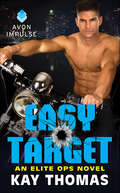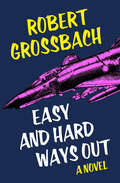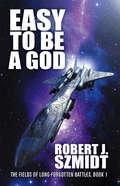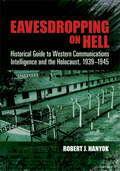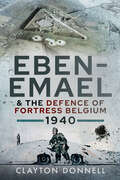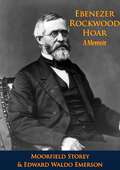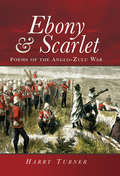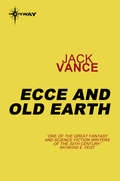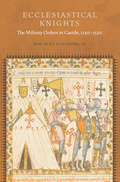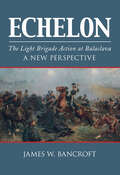- Table View
- List View
East River Column
by Chan Sui-JeungHong Kong's story in the Second World War has been predominantly told as a story of the British forces and their defeat on Christmas Day 1941. But there is another story: the Chinese guerrilla forces who harassed the Japanese throughout the occupation played a crucial part in the escapes from Hong Kong's prisoner of war camps and in rescuing Allied airmen. This neglected part of Hong Kong's war is Chan Sui-jeung's topic in this pioneering book informed by his many contacts with participants in the guerrilla warfare. The guerrilla group usually described as the East River Column gathered momentum in 1937 after China and Japan embarked on full-fledged war. Chan reports on its precursors and the formation of more formal structures that provided the basis for the guerrilla activities in Hong Kong between 1941 and 1945. Just as the guerrilla's story starts before the Second World War, so it goes on after 1945 and is entwined with the civil war and the establishment of the People's Republic of China. An important and valuable part of this book recounts how the leaders of the East River Column fared in the period up to and after the Communist victory. The book also sheds new light on the struggle between the Guangdong party members and the cadres from the north and 'the problem of Guangdong' as it was characterized by Mao Zedong. This book thus finally gives due prominence to the role of the Chinese guerrillas in Hong Kong during the war, while at the same time setting that struggle into the broader contexts of Guangdong province, the long war between China and Japan, and the victory of the Communists and the early years of their rule in the South.
East Tennessee in World War II (Military)
by Dewaine A. SpeaksLike every other red-blooded American, East Tennessee residents did all they could to help end World War II. Locals like "Petie" Siler signed up for service, despite having fought in World War I. Oak Ridge residents worked expeditiously on the Manhattan Project, gathering uranium-235 to fuel the first atomic bomb. Knoxville's Rohm & Haas Chemical Company branch furnished Plexiglas for aircraft. Military veterans Dewaine A. Speaks and Dr. Ray Clift detail the unified sacrifices and contributions of East Tennessee's honorable soldiers and civilians.
East Texas in World War II (Images of America)
by Bill O'NealTexas made a remarkable contribution to the American war effort during World War II . Almost 830,000 Texans, including 12,000 women, donned uniforms, and more than 23,000 Texas fighting men died for their country. America's most decorated soldier, Lt. Audie Murphy, and most decorated sailor, submarine commander Sam Dealey, both were Texans. Texas A&M, an all-male military college, placed 20,000 men in the armed forces, of which 14,000 were officers--more than any other school in the nation, including the U.S. Military Academy at West Point. Gen. Dwight D. Eisenhower, the supreme commander of Allied Forces in Europe, was born in Denison in northeast Texas. Adm. Chester Nimitz, commander in chief of the Pacific Fleet, was born and raised in Texas. Almost 1.5 million soldiers, sailors, and fliers trained at scores of Texas bases. Texas oil fueled the Allied war effort, while Texas shipyards and defense plants provided a flood of war machines and munitions during the war effort.
East Timor Intervention: A retrospective on INTERFET
by John BlaxlandAustralia's involvement in the liberation of East Timor in 1999 was the most decisive demonstration of Australian influence in the region since World War II and the largest military contribution since the Vietnam War. Australian diplomacy and leadership shaped the events that led to the birth of Asia's newest nation.East Timor Intervention looks at the crisis through the prism of key participants and observers on the ground and abroad, including Indonesia's martial law commander Kiki Syahnakri defending his record, the country's first president Xanana Gusm�o on the resolution and poise of Timor's resistance fighters, Australia's Chief of Defence Force Chris Barrie on cobbling the force together, commander of the International Force Peter Cosgrove on the operation, and key policy adviser Hugh White on Canberra's policy contortions in the lead-up to the intervention.This impressive collection includes significant new perspectives on Southeast Asian security affairs and the role Australia can play in regional security and stability.
East West Street: Winner of the Baillie Gifford Prize
by Philippe SandsTHE BRITISH BOOK AWARDS NON-FICTION BOOK OF THE YEAR 2017WINNER OF THE BAILLIE GIFFORD PRIZE and THE JQ-WINGATE LITERARY PRIZETHE SUNDAY TIMES TOP 10 BESTSELLER'A monumental achievement: profoundly personal, told with love, anger and great precision' John le Carré'One of the most gripping and powerful books imaginable' SUNDAY TIMESWhen he receives an invitation to deliver a lecture in the Ukrainian city of Lviv, international lawyer Philippe Sands begins a journey on the trail of his family's secret history. In doing so, he uncovers an astonishing series of coincidences that lead him halfway across the world, to the origins of international law at the Nuremberg trial. Interweaving the stories of the two Nuremberg prosecutors (Hersch Lauterpacht and Rafael Lemkin) who invented the crimes or genocide and crimes against humanity, the Nazi governor responsible for the murder of thousands in and around Lviv (Hans Frank), and incredible acts of wartime bravery, EAST WEST STREET is an unforgettable blend of memoir and historical detective story, and a powerful meditation on the way memory, crime and guilt leave scars across generations.WINNER OF THE HAY FESTIVAL MEDAL FOR PROSE 2017
East West Street: Winner of the Baillie Gifford Prize
by Philippe SandsWINNER OF THE BAILLIE GIFFORD PRIZE FOR NON-FICTION'A monumental achievement: profoundly personal, told with love, anger and great precision' - John le Carré'A triumph of astonishing research ... No novel could possibly match such an important work of truth' - Antony Beevor'Magnificent ... I was moved to anger and to pity. In places I gasped, in places I wept. I wanted to reach the end. I couldn't wait to reach the end. And then when I got there I didn't want to be at the end' - The TimesWhen human rights lawyer Philippe Sands received an invitation to deliver a lecture in the western Ukrainian city of Lviv, he began to uncover a series of extraordinary historical coincidences. It set him on a quest that would take him halfway around the world in an exploration of the origins of international law and the pursuit of his own secret family history, beginning and ending with the last day of the Nuremberg Trials. Part historical detective story, part family history, part legal thriller, Philippe Sands guides us between past and present as several interconnected stories unfold in parallel. The first is the hidden story of two Nuremberg prosecutors who discover, only at the end of the trials, that the man they are prosecuting may be responsible for the murder of their entire families in Nazi-occupied Poland, in and around Lviv. The two prosecutors, Hersch Lauterpacht and Rafael Lemkin, were remarkable men, whose efforts led to the inclusion of the terms 'crimes against humanity' and 'genocide' in the judgement at Nuremberg. The defendant, Hans Frank, Hitler's personal lawyer and Governor-General of Nazi-occupied Poland, turns out to be an equally compelling character.The lives of these three men lead Sands to a more personal story, as he traces the events that overwhelmed his mother's family in Lviv and Vienna during the Second World War. At the heart of this book is an equally personal quest to understand the roots of international law and the concepts that have dominated Sands' work as a lawyer. Eventually, he finds unexpected answers to his questions about his family, in this powerful meditation on the way memory, crime and guilt leave scars across generations, and the haunting gaps left by the secrets of others.Read by Philippe Sands and David Rintoul(p) 2016 Orion Publishing Group
East Wind, Rain: A Novel
by Caroline PaulFrom the New York Times bestselling author of The Gutsy Girl comes this provocative, compelling novel of irrevocable consequences for people thrust unwittingly into a devastating war of nations and American identity—based on a little-known true event. December 1941. The inhabitants of Niihau lead a simple life. Mostly Hawaiian natives, they work the ranch of Niihau's eccentric haole owner, who keeps his island totally isolated from the outside world, devoid of cars, phones, and electricity. But then a plane crash-lands there, and although the villagers rescue the pilot, they have no idea that he has just attacked Pearl Harbor. War has now come to Eden, slowly undoing its tranquillity, widening the cracks in the already troubled marriage of Irene and Yoshio Harada, the island's only Japanese-American couple. It will test everyone's loyalties and all they believe in . . . as Paradise, once within reach, slowly falls victim to its own isolated innocence.
East of Farewell
by Howard HuntEast of Farewell, first published in 1942, is a realistic novel of life aboard a U.S. Navy destroyer in the North Atlantic during World War II. The book centers on the officers and crew, their interactions, their routine tasks aboard ship and as part of a larger convoy, the tensions between “regular navy” men and those serving for just the duration of the war, encounters with German U-boats, and the harsh weather and sea. Author Howard Hunt (1918-2007) served as an ensign aboard a destroyer in the North Atlantic during the early days of the Second World War.
East-South Trade: Economics and Political Economies
by Jacksin M. R. JacksonAn exploration of Eurasia's security environment. The authors examine political-military concerns and economic, ethnic, and environmental issues. Volume 1 covers Russia and the West; volume 2 covers Russia, the Caucasus and Central Asia; and volume 3 covers Russia and East Asia.
Eastern Front Sniper: The Life of Matthäus Hetzenauer (Greenhill Sniper Library)
by Roland KalteneggerEastern Front Sniper is a long overdue and comprehensive biography of one of World War IIs most accomplished snipers.Mathus Hetzenauer, the son of a Tyrolean peasant family, was born in December 1924. He was drafted into the Mountain Reserve Battalian 140 at the age of 18 but discharged five months later.He received a new draft notice in January 1943 for a post in the Styrian Truppenbungsplatz Seetal Alps where he met some of the best German snipers and learned his art.Hetzenauer went on to fight in Romania, Eastern Hungary and in Slovakia. As recognition for his more than 300 confirmed kills he was awarded on the Knight's Cross of the Iron Cross on April 17, 1945.After nearly five years of Soviet captivity Mathus Hetzenauer returned to Austria on January 10, 1950. He lived in the Tyrol's Brixen Valley until his death on 3 October of 2004.
Eastern Front: Encirclement and Escape by German Forces (Eastern Front From Primary Sources)
by Bob CarruthersThe ferocious battles for survival fought by trapped German forces in Russia have become synonymous with that most terrible of all military campaigns. shortly after the war the personal experiences of those who had fought in the battles were collected together as the German report series. These reports include invaluable information from impeccable sources on the pockets formed at Klin, Velikiye Luki, Cherkassy and Kamenets-Podolskiy.Also included are contemporary reports featuring German encirclement tactics, and an in-depth feature on the Kiev operation. This new compilation is essential reading for anyone interested in discovering the real experience of the German forces trapped in Russia.This book is part of the 'Hitler's War Machine' series, a new military history range compiled and edited by Emmy Award winning author and historian Bob Carruthers. The series draws on primary sources and contemporary documents to provide a new insight into the true nature of Hitler's Wehrmacht.The series consultant is David Mcwhinnie creator of the award winning PBS series 'Battlefield'.
Eastern Inferno: The Journals of a German Panzerjäger on the Eastern Front, 1941–43
by Hans Roth&“Remarkable personal journals . . revealing the combat experience of the German-Russian War as seldom seen before . . . a harrowing yet poignant story&” (Military Times). Hans Roth was a member of the anti-tank panzerjager battalion, 299th Infantry Division, attached to the Sixth Army, as the invasion of Russia began. As events transpired, he recorded the tension as the Germans deployed on the Soviet frontier in June 1941. Then, a firestorm broke loose as the Wehrmacht tore across the front, forging into the primitive vastness of the East. During the Kiev encirclement, Roth&’s unit was under constant attack as the Soviets desperately tried to break through the German ring. At one point, after the enemy had finally been beaten, a friend serving with the SS led him to a site—possibly Babi Yar—where he witnessed civilians being massacred. After suffering through a brutal winter against apparently endless Russian reserves, his division went on the offensive again when the Germans drove toward Stalingrad. In these journals, attacks and counterattacks are described in you-are-there detail. Roth wrote privately, as if to keep himself sane, knowing his honest accounts of the horrors in the East could never pass Wehrmacht censors. When the Soviet counteroffensive of winter 1942 begins, his unit is stationed alongside the Italian 8th Army, and his observations of its collapse, as opposed to the reaction of the German troops sent to stiffen its front, are of special fascination. Roth&’s three journals were discovered many years after his disappearance, tucked away in the home of his brother. After his brother&’s death, his family discovered them and sent them to Rosel, Roth&’s wife. In time, Rosel handed down the journals to Erika, Roth&’s only daughter, who had emigrated to America. Roth was likely working on a fourth journal before he was reported missing in action in July 1944. Although his ultimate fate remains unknown, what he did leave behind, now finally revealed, is an incredible firsthand account of the horrific war the Germans waged in Russia.
Easternization: The Spread of Japanese Management Techniques to Developing Countries
by Raphael Kaplinsky Anne PosthumaJapanese industry has shown its superiority in a range of traded goods sectors. It was thought that this competitive advantage arose from the use of electronics-based flexible automation technologies, but it is now clear that the major source of this industrial strength is in the development and diffusion of new management techniques such as just-in-time production and total quality management.A number of Western firms have begun to introduce these management techniques and have begun to reap significant benefits, not just in lowering costs but also in improving product variety and quality, and in being able to satisfy customer needs more effectively. This is a practical and relevant book for those involved in the areas of policy and production, as well as being of relevance to those in the teaching and research communities.
Easy Day for the Dead: A SEAL Team Six Outcasts Novel (The SEAL Team Six Outcasts Novels)
by Howard E. Wasdin Stephen TemplinInfusing the hardcore intensity of their New York Times bestselling memoir, SEAL Team Six, into two pulse-pounding novels, Howard E. Wasdin and Stephen Templin plunge readers into the electrifying action of the Outcasts, the elite SEAL warriors who covertly defy the rules when America&’s safety is on the line. They are the heroes the world will never know…Working under the radar in Special Ops unit Bitter Ash, these men and women take on the missions no one else wants. Every op is the highest possible risk and any moment could be their last. Now, they must parachute into the harsh desert on the border with Afghanistan, to meet a beautiful agent who will lead them to an Iranian biological warfare site they are to destroy with a suitcase-size nuke. And, like most missions, nothing goes according to plan, with a maniacal Revolutionary Guard officer a razor&’s edge away from exposing them. Then the team must free a hostage in Lebanon before the fight takes them halfway around the world—in a frantic battle of courage and stealth that America cannot afford to lose.
Easy Target
by Tom SmithTom Smith didn't seem like the perfect candidate to fight for the United States in the Vietnam conflict, but being recruited for active duty gave him more than he bargained for. Chosen as an aero scout leading an elite squadron on combat missions, his job was to attract Viet Cong fire in order that the enemy be located and destroyed--a job with a fifty percent survival rate. From flying battle runs to rescuing wounded infantry to pulling off daring last-minute escapes, this is the incredible and unforgettable true first-hand account of the unlikeliest hero ever to survive a war.
Easy Target: An Elite Ops Novel (Elite Ops #3)
by Kay ThomasA secret crush turns to passion in this romantic suspense when a woman is rescued by her brother’s best friend, an elite, military trained agent.AEGIS: an elite team of ex-military men who will do anything for their country...and their womenFighting to clear her brother of murder, freelance reporter Sassy Smith is suddenly kidnapped and thrown into a truck with other women who are about to be sold...or worse. When she sees an opportunity for escape Sassy takes it, but she may have just jumped from the frying pan into the fire.Former Marine Bryan Fisher (aka Hollywood) is no stranger to dangerous situations, or to his best friend’s little sister. When he rescues Sassy, Bryan is determined to keep her safe...if he can keep his hands off of her. Because Sassy is all grown up and not at all like the girl he used to know. But he’s got bigger problems. And with enemies coming at them from every corner, Bryan and Sassy will need to work together if they’re going to survive.
Easy and Hard Ways Out: A Novel
by Robert GrossbachAn underachieving engineer building a fighter plane faces a life-changing decision in this Vietnam-era novel perfect for fans of Kurt Vonnegut, Joshua Ferris, and Joseph Heller. This furious, slapstick tale has been praised by the New York Times as one of the &“best and brightest&” novels about the Vietnam War. We follow the travails of Harvey Brank and his fellow employees, all undrafted malcontents working in a spectacularly small-minded, almost Kafkaesque engineering company. Assigned to build a fighter plane and drawn into office intrigues, Brank faces impossible demands. His wife, despairing of his patchy employment history and restlessness, hopes against hope that Brank won&’t get himself fired this time. But what do you do when everything conspires against your vision of a decent, peaceable life?Easy and Hard Ways Out is a blunt, freewheeling look at the men who stay home during wartime—a story about the everyday, with a timeless moral at its heart.
Easy to be a God (The Fields of Long-Forgotten Battles)
by Robert J. Szmidt Robert SzmidtAs humanity colonizes outer space, they encounter a terrifying alien threat in this military sci-fi thriller. In the twenty-fourth century, and human civilization has made a great leap forward, colonizing over a thousand planets and exploring thousands more. But after surviving a bloody civil war, they now face mysterious new threats. In the Xan-4 System, scientists and Federation soldiers observe two alien races from an orbital station. Sergeant Henryan Swiecki must identify a group of people who—against procedures—are trying to save one of the races. At stake is not only the survival of the Warriors of the Bone, but also Henryan&’s life. Meanwhile, in the distant New Rouen System, a recycling ship known as the Nomad finds a millennia-old shipwreck while clearing the fields of long-forgotten space battles. The derelict&’s advanced technology is impressive...but the being found onboard could shake the very foundation of human civilization . . .
Eavesdropping on Hell: Historical Guide to Western Communications Intelligence and the Holocaust, 1939-1945 (Dover Military History, Weapons, Armor)
by Robert J. HanyokThis recent government publication investigates an area often overlooked by historians: the impact of the Holocaust on the Western powers' intelligence-gathering community. A guide for researchers rather than a narrative study, it explains the archival organization of wartime records accumulated by the U.S. Army's Signal Intelligence Service and Britain's Government Code and Cypher School. In addition, it summarizes Holocaust-related information intercepted during the war years and deals at length with the fascinating question of how information about the Holocaust first reached the West.The guide begins with brief summaries of the history of anti-Semitism in the West and early Nazi policies in Germany. An overview of the Allies' system of gathering communications intelligence follows, along with a list of American and British sources of cryptologic records. A concise review of communications intelligence notes items of particular relevance to the Holocaust's historical narrative, and the book concludes with observations on cryptology and the Holocaust. Numerous photographs illuminate the text.
Eben-Emael and the Defence of Fortress Belgium, 1940
by Clayton DonnellIn the early morning of 10 May 1940, the sky literally fell on the heads of the defenders of Fort Eben-Emael, considered to be Belgium's most powerful fortress. This huge structure, with its powerful artillery and infantry weapons, was the key to the Meuse and Albert Canal defences. In the darkness of the pre-dawn, German DFS 230 gliders drifted silently over the southern Netherlands, landing one by one on top of Eben-Emael. Within minutes German Special Forces troops destroyed most of the fort’s weapons and observation capabilities. The following day, the garrison surrendered, and the door to Belgium and France was open. But, as Clayton Donnell relates in this perceptive and meticulously researched study, Eben-Emael was only one of the nineteen forts of the fortified positions of Liège and Namur attacked in May 1940. Three new and sixteen refurbished forts held out for several days, and fought to the death. The story he tells contradicts the common assumption that these static defences were rolled over or bypassed –powerless to resist the overwhelming force of the German combat engineer’s assaults, Stuka bombs and heavy artillery shells. In vivid detail he demonstrates that their importance in the 1940 campaign has been seriously under reported, and he gives clarity to some of the legends that have grown up around the capture of Eben-Emael itself.
Ebenezer Rockwood Hoar; A Memoir
by Edward Waldo Emerson Moorfield StoreyFascinating biography of legal titan, noted abolitionist and diplomat Ebenezer Hoar.Ebenezer Hoar was admitted to the bar in 1835, and served the law at the bar and on the bench for more than a half century. He was a staunch Whig and a proponent of abolition of slavery. He served as Attorney General of the United States for more than a year during the first term of President Grant. He was also a member of the House of Representatives in 1872 and 1873 and an Associate Justice of the Supreme Judicial Court.
Ebony & Scarlet: Poems of the Anglo-Zulu War
by Harry TurnerThe nineteenth century saw the British army engaged in a series of conflicts around the globe. Iin almost every continent the redcoats of British soldiers seemed to be in perpetual action against enemies of the Crown. The Anglo-Zulu War, fought in southern Africa in 1879, was one of the bloodiest of these conflicts, and one of the most famous, and it has fascinated historians ever since. But the story has never, until now, been re-told in verse and that is what Harry Turner does in the sequence of poems he has composed for this memorable volume. He concentrates on the relationship between the British and the Zulus, on the politics and ambition that gave rise to the war and on the series of bloody battles that followed in particular at Isandlwana, Rorke's Drift and Ulundi. Graphically he recalls how King Cetshwayo's Zulu warriors, armed mainly with spears, gave the British a mauling before they were finally overcome. The story has often been told before, but rarely in such an original and evocative way. Harry Turner's work will be an absorbing introduction to the subject for readers who are coming to it for the first time, and it will add a new dimension to the understanding of readers who are familiar with the many more conventional histories of the conflict.
Ecce and Old Earth
by Jack VanceThis sequel to "Araminta Station", features the character of Glawen Clattuc, who helped save the unique planet Cadwal. The charter that granted Cadwal conservation has disappeared - and Glawen and Wayness Tamm are sent across a variety of planets to try and retrieve it.
Ecclesiastical Knights: The Military Orders in Castile, 1150-1330 (Fordham Series in Medieval Studies)
by Sam Zeno Conedera“Warrior monks”—the misnomer for the Iberian military orders that emerged on the frontiers of Europe in the twelfth century—have long fascinated general readers and professional historians alike. Proposing “ecclesiastical knights” as a more accurate name and conceptual model—warriors animated by ideals and spiritual currents endorsed by the church hierarchy—author Sam Zeno Conedera presents a groundbreaking study of how these orders brought the seemingly incongruous combination of monastic devotion and the practice of warfare into a single way of life.Providing a detailed study of the military-religious vocation as it was lived out in the Orders of Santiago, Calatrava, and Alcantara in Leon-Castile during the first century, Ecclesiastical Knights provides a valuable window into medieval Iberia. Filling a gap in the historiography of the medieval military orders, Conedera defines, categorizes, and explains these orders, from their foundations until their spiritual decline in the early fourteenth century, arguing that that the best way to understand their spirituality is as a particular kind of consecrated knighthood.Because these Iberian military orders were belligerents in the Reconquest, Ecclesiastical Knights informs important discussions about the relations between Western Christianity and Islam in the Middle Ages. Conedera examines how the military orders fit into the religious landscape of medieval Europe through the prism of knighthood, and how their unique conceptual character informed the orders and spiritual self-perception.The religious observances of all three orders were remarkably alike, except that the Cistercian-affiliated orders were more demanding and their members could not marry. Santiago, Calatrava, and Alcantara shared the same essential mission and purpose: the defense and expansion of Christendom understood as an act of charity, expressed primarily through fighting and secondarily through the care of the sick and the ransoming of captives. Their prayers were simple and their penances were aimed at knightly vices and the preservation of military discipline. Above all, the orders valued obedience. They never drank from the deep wellsprings of monasticism, nor were they ever meant to.Offering an entirely fresh perspective on two difficult and closely related problems concerning the military orders—namely, definition and spirituality—author Sam Zeno Conedera illuminates the religious life of the orders, previously eclipsed by their military activities.
Echelon: The Light Brigade Action at Balaclava - A New Perspective
by James W BancroftLord Cardigan’s cavalry charge on 25 October 1854 at the battle of Balaclava ‘into the valley of death’ is surely one of the most famous actions in military history. Is there anything new to say about it in print? Yes there is, because most publications have concentrated on commanding officers Lucan, Cardigan and the fatal actions of Nolan. But there were 670 men in the charge and by collating the evidence from the many eyewitnesses James Bancroft offers a new and more accurate appraisal of events. Cardigan’s description of the action was quoted at length in the House of Commons: ‘… with the batteries vomiting forth upon us shells and shot, round and grape, with one battery on our right flank and another on the left … when we came to within a distance of fifty yards from the mouths of the artillery which had been hurling destruction upon us, we were, in fact, surrounded and encircled by a blaze of fire.’ One question of course – which the author, who has been studying the subject for many years, addresses – is how anyone survived.
